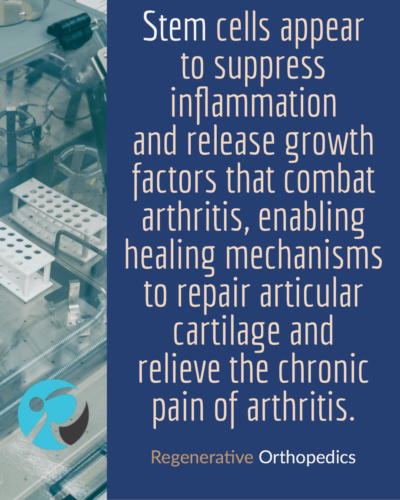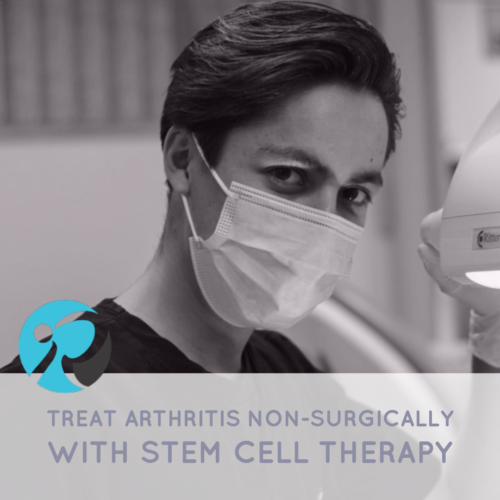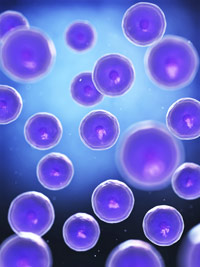OrthoRegen® is a medical clinic specializing in Stem Cell Treatment in the Los Angeles area. If you are looking to avoid surgery in your joints or spine, then we are what you are looking for since we offer effective non-surgical alternatives for joint and spine repair.
Regenerating a person’s joints and spine is not something of the future: it is happening today! Last year in the US, there were 3.5 million total joint replacements and another 35 million joint surgeries. Surgery can always be done but never un-done, which is why people in increasing numbers are seeking non-surgical alternatives to joint and spine surgery. Cutting out a part of a joint or injecting it with steroids is not the answer. Stem Cell Treatment for Joints is the answer.
Watch the testimonials on this page, or see many more on our Testimonials Page.

Our Stem Cell technique for joints and spine is The Gold Standard for stem cell regeneration. We use all four kinds of regenerative Orthopedics for this procedure to help you avoid invasive surgery. Many other clinics only use one or two of these procedures, but not all four.
Using two sources of stem cells (bone and fat) as well as PRP Prolotherapy and Dextrose Prolotherapy is The Gold Standard for stem cell regeneration.
Again, this procedure is usually used for cases where you have been told to have your joint replaced, have bone-on-bone, advanced arthritis, severe meniscus or labral tear, or other aggressive injuries. This is only recommended after a very thorough history and physical exam. It is important to have an x-ray to confirm what is known from the above exams. Not everyone is a candidate for this procedure, but many are.
Why is it so important that you know about this alternative to joint replacement surgery? Because once the surgery is done, it cannot be undone!
Bone Marrow Stem Cells
Stem cells are contained within the bone marrow. This has been shown in studies for many years now. Harvesting them from one’s own body eliminates the possibility of cross-reaction or rejection since it is your own body supplying the stem cells. This autologous (meaning “obtained from oneself”) bone marrow aspirate contains not only mesenchymal stem cells (cells that are able to develop into the tissues such as bone and cartilage) but also progenitor cells, which are a different type of stem-like cell.
Bone marrow also contains other cells that produce growth factors and cytokines (cells that affect the behavior of other cells). These cytokines aid in fibroblastic proliferation. Fibroblasts are cells that synthesize the structural framework. Stem cells have the ability to form tissues like bone, cartilage, labrum, meniscus, ligaments, and more. All this allows for the repair and remodeling of cartilage, bone, and other soft tissue structures such as meniscus, labrums, ligaments, and tendons.
Schedule Your Appointment Today!
Adipose Stem Cells
On the other hand, adipose tissue is also a rich source of adult stem cells. These cells, harvested from one’s own fat, have an extensive proliferative capacity and can differentiate into multiple cell lines. Stem cells derived from adipose tissue can differentiate ligaments, bone, cartilage, muscle, or ligaments. This type of stem cell is now being used in musculoskeletal medicine to regenerate the above tissues and to provide a scaffolding to hold the stem cells in place and allow them to grow. Adipose-derived stem cells are similar but not identical to bone marrow cells.

Not all injuries require stem cells to heal. The success rate with traditional Prolotherapy (both Dextrose and PRP) is in the 90%+ range for all patients. However, for those cases of advanced arthritis, severe meniscus tears or labral tears, bone-on-bone, aggressive injuries, or where one has been told to have their joint replaced, some may need to use Stem Cell Prolotherapy to regenerate the defective joint. I use this in combination with PRP Prolotherapy (to accelerate stem cell healing) and with Dextrose Prolotherapy (to strengthen and stabilize the surrounding support structures).
As more and more research comes out, what is known by a few physicians is being proven. A recent research study was conducted and titled, “Transplanted bone marrow and fat mesenchymal stem cells with platelet-rich fibrin glue scaffold stimulate full-thickness cartilage defects to heal.”
Several human studies have been done using bone marrow and fat stem cells for articular cartilage lesions. Articular cartilage is a type of cartilage that covers joint surfaces and is most susceptible to injury compared to other types of cartilage. Researchers at Cairo University School of Medicine and the University of Pittsburgh School of Medicine reported on the use of bone marrow mesenchymal stem cells and a platelet-rich fibrin scaffold to heal full-thickness cartilage defects in five patients. The researchers successfully studied the treatment results from the bone marrow mesenchymal stem cells.
 Articular Cartilage has limited repair capacity, and marrow-stimulation procedures such as microfracture, osteochondral grafts, and autologous cartilage implantations have had limited success in articular cartilage defects. The researchers from this study chose mesenchymal stem cells from bone marrow because these have the ability to differentiate into cartilage cells. In the case of these five patients, the bone marrow was harvested from the iliac crest (hip bone).
Articular Cartilage has limited repair capacity, and marrow-stimulation procedures such as microfracture, osteochondral grafts, and autologous cartilage implantations have had limited success in articular cartilage defects. The researchers from this study chose mesenchymal stem cells from bone marrow because these have the ability to differentiate into cartilage cells. In the case of these five patients, the bone marrow was harvested from the iliac crest (hip bone).
Platelets were used as a scaffold because platelets contain various growth factors that stimulate cartilage regeneration. The researchers expected that the biological effect of multiple growth factors on tissue regeneration is greater than that of a single growth factor.
The patients showed significant functional improvement. Two of the patients underwent arthroscopy after the transplantation and showed near-normal articular cartilage. Three postoperative MRIs revealed complete healing and congruent cartilage tissue, whereas two patient MRIs showed incomplete (it was partial and not 100% complete) congruity in the cartilage tissue.
The researchers concluded that the transplantation of autologous culture-expanded bone marrow-mesenchymal stem cells in platelet rich-fibrin glue shows great promise in the treatment of full-thickness articular cartilage defects, particularly large-sized defects (>4 cm). The positive 1-year clinical outcomes support further randomized controlled clinical trials of this treatment modality with larger numbers of patients and longer follow-up periods.
Schedule Your Appointment Today!
If you’ve been told that you need to have joint replacement surgery — whether that’s knee replacement surgery, hip replacement surgery, shoulder replacement surgery (or any other joint), or if you’ve been told that you need to have spine surgery due to arthritis, bone-on-bone, or other conditions, you owe it to yourself to examine all other alternatives to surgery before going under the knife.
Joint Replacement Surgery and Spine Surgery are very invasive procedures, and each comes with its own long list of reasons to avoid it at all costs: hospital stays, potential (dangerous) complications, long recovery times, and the need to have the procedure redone at some point. Make an appointment with Dr. Peter Fields for an evaluation to see if you are a good candidate for my Gold Standard Stem Cell Treatment for Joints and Spine. Click the blue button on this page, or call 310-453-1234 to make an appointment now.